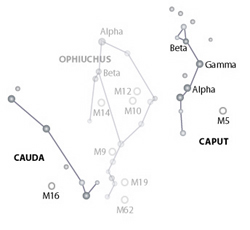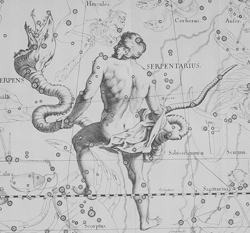Location: Visible between latitudes 80 and -80 degrees
Coordinates:
Right Ascension: 17h
Declination: 0º
 The story behind the name: Serpens, the Latin word for serpent, is the only constellation divided into 2 parts: Serpens Caput (the head) and Serpens Cauda (the tail). The two parts wind around the figure of Asclepius, the Greek god of healing and medicine. Serpens is the same snake found on the symbol of medicine worldwide.
The story behind the name: Serpens, the Latin word for serpent, is the only constellation divided into 2 parts: Serpens Caput (the head) and Serpens Cauda (the tail). The two parts wind around the figure of Asclepius, the Greek god of healing and medicine. Serpens is the same snake found on the symbol of medicine worldwide.
One of the many legends surrounding these figures has Asclepius learning the healing powers of plants from a snake. It is said he either crushed a snake accidentally or saw a dead snake in his travels and, soon afterwards, witnessed a second snake with a mouth full of herbs revive its dead brother. Asclepius took some of the herbs for himself and studied them. He learned to use them to raise the dead and is said to have resurrected Orion after his death by the sting of Scorpius. His ability to raise the dead alarmed Hades, god of the underworld, who persuaded his brother Zeus to kill Asclepius with a thunderbolt. After hurling the fatal bolt, Zeus regretted his decision and placed Asclepius in the sky with the Serpens, calling him Ophiuchus, or "serpent bearer", in recognition of his remarkable healing skills.
Scorpius is also mentioned in the legend of Phaeton, the headstrong son of Apollo and the nymph Clymene. Phaeton was taunted at school for his claim to be the son of a god. He traveled to the palace of the Sun to ask his father for proof of his divine birth. Apollo acknowledged Phaeton as his son and granted him one wish. Phaeton asked to drive the chariot of the Sun, his father's responsibility of bringing day to the world. Apollo, deeply troubled and regretful, warned his son of the dangers of driving the chariot through a sky littered with monsters (among other perils). Apollo mentioned the horns of the Bull, the Lion's jaws, the Scorpion's sting and the Crab's claws. Phaeton rashly insisted and, as his father feared, lost his grip on the reins at the sight of the huge Scorpion. With the chariot pulling the burning Sun completely out of control, the Earth became scorched and was saved only by a thunderbolt from Zeus which struck Phaeton dead.
Introduction to Constellations | Constellation Sources | Constellations Index
Objects observed by Chandra in Serpens:


